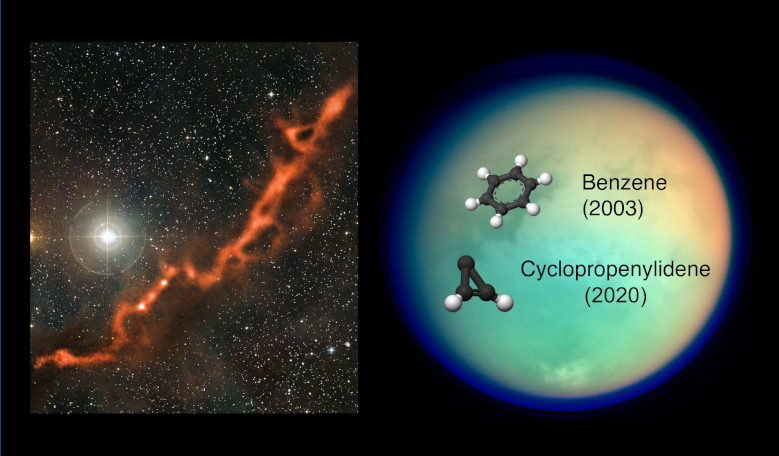A carbon-based molecule that may be a precursor to more complex compounds that could form or feed life has been detected on Saturn’s largest moon, Titan.Called cyclopropenylidene, or C3H2, the compound is a “cyclic,” or closed-loop molecule.
These types of molecules are very stable and although C3H2 is not known to be used in modern-day biological reactions, they are known to form the backbone rings for nucleobases.
Nucleobases in turn form nucleotides - the building blocks of DNA and RNA – which store genetic information in the cells of all living organisms.
Cyclopropenylidene is only the second such cyclic molecule to be found on Titan - the first being Benzene (some years ago now).
Benzene (C6H6) is another important organic chemical species as it helps to form amino acids; these form the building blocks of proteins and are compounds that play many critical roles in your body.
With compounds such as these floating around in an atmosphere four times denser than Earth’s, when coupled with its clouds, rain, lakes and rivers, and even a subsurface ocean of salty water, the large moon offers vast appeal in the search for primitive life,
“We’re trying to figure out if Titan is habitable,” said Rosaly Lopes, a senior research scientist and Titan expert at NASA’s Jet Propulsion Laboratory (JPL) in Pasadena, California. “So we want to know what compounds from the atmosphere get to the surface, and then, whether that material can get through the ice crust to the ocean below, because we think the ocean is where the habitable conditions are,” Lopes added.
Aside from being incredibly thick and dotted with hydrocarbons, Titan’s atmosphere is made mostly of nitrogen, like Earth’s, with a hint of methane (CH4).
3.8 to 2.5 billion years ago, methane filled Earth’s air instead of oxygen, so if conditions on Titan today are similar to those on Earth long ago, the types of molecules that might be sitting on Titan’s surface could be the same ones that formed the building blocks of life on Earth.
“We think of Titan as a real-life laboratory where we can see similar chemistry to that of ancient Earth when life was taking hold here,” said Melissa Trainer, a NASA Goddard astrobiologist.
NASA plan on sending a 'quadcopter' to study the surface of Titan in around 2026. Dubbed Dragonfly, Trainer is the mission’s deputy principal investigator and lead of an instrument on the Dragonfly rotorcraft that will analyse the composition of Titan’s surface.
“We’ll be looking for bigger molecules than C3H2,” Trainer said, “but we need to know what’s happening in the atmosphere to understand the chemical reactions that lead complex organic molecules to form and rain down to the surface.
Although the hunt is on for larger hydrocarbons, discovering this relatively small hydrocarbon was still something of an unanticipated find, says Conor Nixon, a planetary scientist at NASA’s Goddard Space Flight Center in Greenbelt, Maryland.
Connor, who led the search using the Atacama Large Millimeter/submillimeter Array (ALMA) in Chile says when he realised he was looking at cyclopropenylidene, "my first thought was, ‘well, this is really unexpected.’”
It was unexpected because although C3H2 has been found in pockets of gas throughout the galaxy, it has never been detected in any other atmosphere before now.
Cyclopropenylidene can react easily with other molecules it comes into contact with and form different species but Nixon’s team were able to identify small amounts of the compound likely because they were looking in the upper layers of the moon’s atmosphere, where there are fewer other gases for C3H2 to interact with.
Due to its rarity in other atmospheres, Nixon pored through research papers published from analyses of data from NASA’s Cassini spacecraft, to double check it was really C3H2 that the team were seeing.
Cassini made 127 close flybys of Titan between 2004 and 2017 and indeed, the ground-breaking mission did spot evidence for an electrically charged version of the same molecule, with its mass spectrometer during its close encounter with the moon.
“It’s a very weird little molecule, so it’s not going be the kind you learn about in high school chemistry or even undergraduate chemistry,” said Michael Malaska at JPL. “Down here on Earth, it’s not going be something you’re going to encounter.”
Malaska, who used to work in the pharmaceutical industry before falling in love with Titan and switching careers to study it, and other scientists like him, are therefore keen to learn more about cyclopropenylidene and how it might interact with gases in Titan’s atmosphere.
With Titan proving to be a treasure trove of new compounds, especially ones that allow you to build biologically important molecules, finding species like C3H2 is really important in seeing the big picture of Titan.
“Every little piece and part you can discover can help you put together the huge puzzle of all the things going on there,” adds Malaska.
These findings have now been published in the Astronomical Journal.











